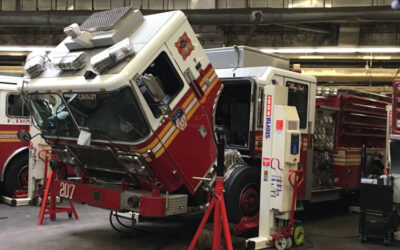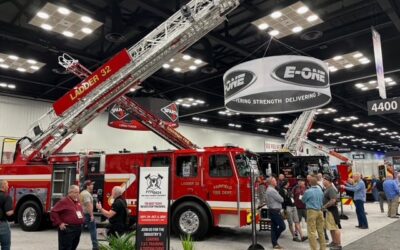By Bill Adams
After a year’s hiatus, the Fire Department Instructor’s Conference (FDIC) in Indianapolis, IN, had numerous apparatus on display from multiple vendors. In addition to unveiling new products and apparatus designs, most rigs were equipped with traditional accoutrements such as access steps and grab rails.
The National Fire Protection Association NFPA 1901 Standard Fire Automotive Fire Apparatus, Sections 15.7 through 15.86 has all the nitty-gritty requirements for steps and handrails. The only reference I will make here to NFPA 1901 is Sentence 15.8.5 which states: “Handrails and handholes shall be constructed so that three points of contact (two hands and one foot, or one hand and two feet) can be maintained at all times while ascending and descending.”
I have nothing against access steps and handrails (aka grab rails) themselves. However, I do question (what could be) their illogical placement on some apparatus. It appears common sense was not factored in in determining some types and locations. In others, their absence is obvious.
There is no intent to demean, discredit, or find fault with any manufacturer or purchaser with these photographs. Manufacturers build to customers’ specifications. Occasionally, additional steps and handrails are added by local dealerships prior to final delivery. If questions need answering or criticism is to be leveled about specific apparatus, direct them to the fire department or the specification writer.
If a purchaser does not specifically call for steps and handrails, the manufacturer still must provide them for the rig to be compliant. BUT—if purchasers do not specify their exact styles, sizes, and locations, the manufacturer will choose for them. If a requirement is not in writing—it does not exist. Comments herein are mine and not reflective of the website or parent magazine. The intent is to make future purchasers aware. Many fold-down access steps are dual-purpose constructed with combination hand holes.

Quints are busy “places of employment”—especially around the operator’s panel. This one has a handrail just visible on top of the pump house plus a decent-sized vertical one on the compartment’s face outboard of the combination grab handle/access steps. Visualize climbing up them while the pump operator is doing his thing. Will the pump-to-tank or tank-fill control rods in the extended position hinder climbing? Imagine inadvertently stepping on a control rod while descending.
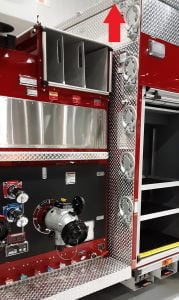
This rig has a top-mount operator’s panel, so there are no controls near the five vertical access steps. A handrail is just visible at the very top of the compartment. Adding one underneath the crosslays would facilitate hanging on with one hand while loading hose with the other (e.g., “one hand for me and one hand for thee”).
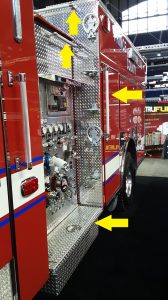
Also sporting five vertical access steps, this rig has three good-sized handrails. A great idea is having a flush treadplate cover over the running board hose trough—eliminating an obvious trip/fall/break-your-ankle “or worse” hazard.
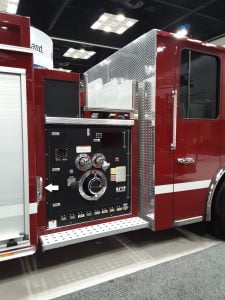
One access step and no handrails near it or near the crosslays.
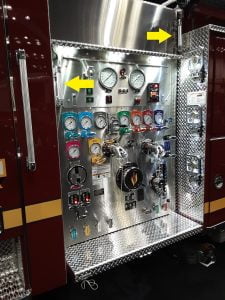
Three access steps with a handrail above them. (Large-sized master and line gauges are easy to read.)
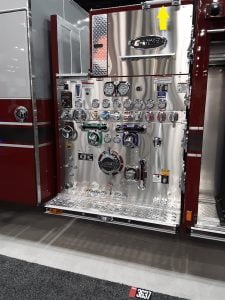
This rig has a single handrail in the upper section of the pump house adjacent to the vertical access steps. Note the backboard storage to the right of the crosslays. Adding handrails in this area would facilitate accessing the backboards and reloading the crosslays.
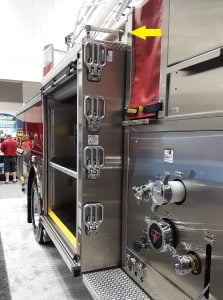
Another handrail above vertical access steps. Running boards are around 12 inches deep. Half of a firefighter’s rear-end has to compete with controls and hose connections in those 12 inches when climbing up or down. It’s not safe. Making access to the top of a rig only on the opposite side from the operator’s panel makes sense. Making the only access to the top of a rig from its rear makes more sense.

On the officer’s side of this quint there’s a full-width horizontal handrail below the crosslays—nice. Note the flip-down access step on the side of the open-topped hose well.

The wide pump panel on this quint enables keeping controls away from the vertical access steps mounted on compartment sides—whether by design or not.
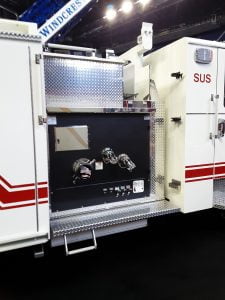
It’s obvious some sort of long-handled hook will be stored vertically on the cab’s rear wall. If the hook is in use, there’s not much to hang onto when accessing or reloading the crosslays.
Rear-Access Steps & Grab Handles
The types, sizes, and locations of access steps and handrails are just as varied on the rear of a pumper. Purchasers should specify the exact types, sizes, and locations of them. If not, you might get the least expensive and smallest sizes “that just meet your specs.” Hope you like their locations, and they are easy and safe to climb.

This rig has “squared off” rear beavertails and a large rear work platform—historically known as the rear step or tailboard. It is unknown why the access steps are mounted on the beavertail; it looks like they’d be awkward to climb.
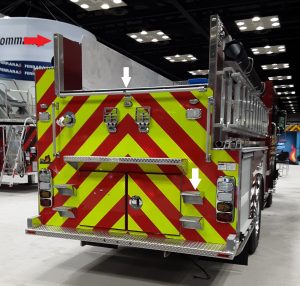
This pumper with a simple flatback design has a full-width handrail and two folding steps below the hose bed. It features an intermediate treadplate step above the rear compartment and two permanent access steps on each side of it. It appears easy to work off. I would have extended the two vertical handrails upwards to the top of the hose bed side sheets (red arrow).
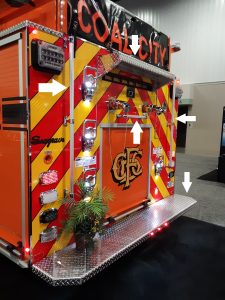
The rear of this pumper has a full-height vertical handrail on each side of another good-size tailboard. If the enclosure protecting the rear arrow type traffic light beneath the hose bed is intended to be a step, specifications should denote the same so manufacturers are obligated to construct it appropriately. I like the extra handrail between the two discharges. The potted plant does not appear to be NFPA compliant…
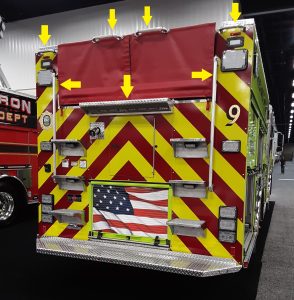
Some thought went into accessing the top of this rig. Three “wider than normal” steps are on each side of the rear compartments. There are handrails on each side of the hose bed as well as one on each hose bed cover. The vertical handrails extend above the hose bed floor. The typical step/cover for the rear traffic advisor light is just below the hose bed. It appears easy and safe to work off.
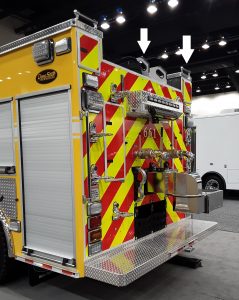
Rear slide-in storage on each side of this pumper-tanker’s tank necessitates multiple access steps. Handrails on each side at the top as well as “hand holes” cut into the hose bed dividers facilitates climbing. It sports another “firefighter-friendly” rear-work platform.
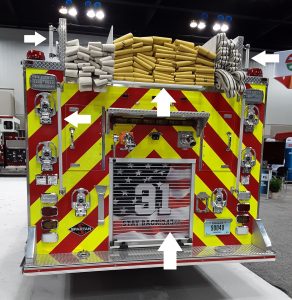
Another instance where slide-in storage on both sides of a booster tank pretty much negates the use of an access ladder at the rear. Five handrails help navigate the six flip-down steps. Note the distance specified after KEEP BACK on the rear compartment door. Never forget.
***
How often do purchasers at a trade show actually “try” using the access steps and handrails on the rigs being exhibited? If you do try it, REMEMBER that on the fireground you’ll most likely be doing it while wearing full rubber goods and not sneakers and shorts. And, at a trade show you’ll probably not be carrying equipment up or down, nor will you have an officer telling you to “step it up—move with a purpose—c’mon lets go!”




